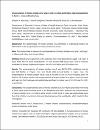Seroprevalence of herpes simplex virus types 1 and 2 in Indian and Filipino migrant populations in Qatar: a cross-sectional survey
التاريخ
2018-09-18البيانات الوصفية
عرض كامل للتسجيلةالملخص
Background: The epidemiology of herpes simplex virus infections is of growing interest but
information on its seroprevalence in many countries is scarce.
Aims: This study aimed to measure the seroprevalence of herpes simplex virus type 1 and type 2
in Filipino and Indian men living in Qatar.
Methods: Blood serum specimens were collected from male blood donors aged ≥ 18 years in
Qatar from 2013 to 2016. HerpeSelect® 1/2 and Euroline‐WB assays were used to measure
antibodies to herpes simplex virus types 1 and 2 in 120 Filipino and 325 Indian men.
Results: The seroprevalence of herpes simplex virus‐1 was 84.9% (95% confidence interval
(CI): 78.4–90.0%) in Filipino men and 48.3% (95% CI: 43.6–53.0%) in Indian men. The
seroprevalence of herpes simplex virus‐2 was 8.3% (95% CI: 4.6–13.7%) in Filipinos and 3.7%
(95% CI: 2.2–5.9%) in Indians. The seroprevalence of herpes simplex virus types 1 and 2 increased
with age, but this trend was only statistically significant in Indian men (P = 0.013 and P = 0.011
respectively).
Conclusions: The seroprevalence rates of herpes simplex virus‐2 in Filipino and Indian men living
in Qatar were similar to those found in the Philippines and India. However, the seroprevalence
of herpes simplex virus‐1 in Indians, while similar to that found in India, was substantially lower
than that of other countries in Asia and developing countries worldwide, which needs further
investigation.
المجموعات
- أبحاث مركز البحوث الحيوية الطبية [834 items ]
- العلوم الحيوية الطبية [845 items ]


